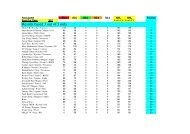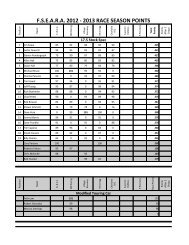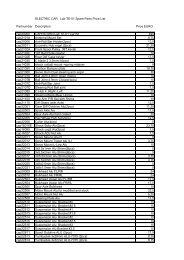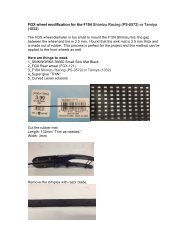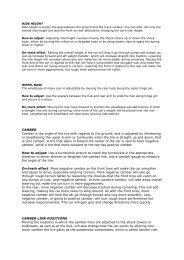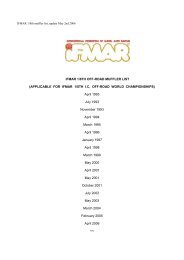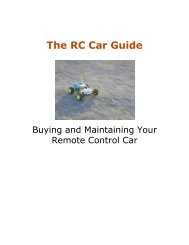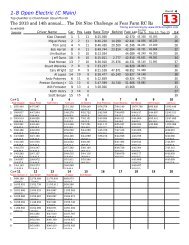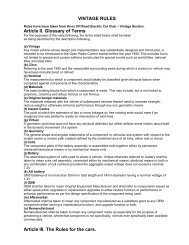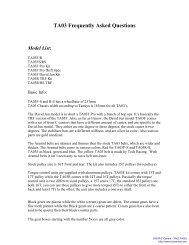Roll Center Myths and Reality.pdf - Zzyzx Motorsports
Roll Center Myths and Reality.pdf - Zzyzx Motorsports
Roll Center Myths and Reality.pdf - Zzyzx Motorsports
- No tags were found...
Create successful ePaper yourself
Turn your PDF publications into a flip-book with our unique Google optimized e-Paper software.
<strong>Roll</strong> <strong>Center</strong> - <strong>Myths</strong> <strong>and</strong> <strong>Reality</strong><strong>Roll</strong> <strong>Center</strong><strong>Myths</strong> <strong>and</strong> <strong>Reality</strong>by Wm. C. MitchellWm. C. MitchellThe <strong>Roll</strong> <strong>Center</strong>“<strong>Roll</strong> <strong>Center</strong>” is the most misunderstood term in vehicle dynamics. A fairly simpleconcept - how much lateral force applied at the tire contact patch is transformed intovertical force - has generated a remarkable number of myths. The “roll center” is a simplemeasure, derived from symmetric production car design, extrapolated to asymmetricracing cars, which overwhelmed the underlying reality. The vary name “roll center”implies much more than it delivers.Tires generate forces which produce lateral <strong>and</strong> longitudinal acceleration. This processinvolves complex concepts ranging from molecular adhesion to the conformity of a softtire to an irregular road surface. But the result is simple: a force in the plane of the roadsurface <strong>and</strong> a vertical force perpendicular to the road surface. The best analogy, due totire author Paul Haney, involves a broom. If you hold the h<strong>and</strong>le of the broom low it mayglide over a washer lying on the ground. If you raise the h<strong>and</strong>le it becomes harder to pushbut there is more vertical force pushing the bristles into the ground <strong>and</strong> more likely todislodge that washer.The reality of this analogy is the angle of the broom h<strong>and</strong>le, not the height of the end. Cutthe broom h<strong>and</strong>le in half but maintain the angle <strong>and</strong> the effect is the same: the height ofthe end is irrelevant. “<strong>Roll</strong> center” is a measure of the height of the broom h<strong>and</strong>le, not theangle. <strong>Reality</strong> is the angle snf the resulting forces.The HistoryMost of vehicle dynamics theory was developed around production cars simply becausethere were many more production car engineers than racing engineers (<strong>and</strong> there stillare). Production car suspensions are usually symmetric with the center of gravity near thecenterline of the car.Production cars are rarely subject to large lateral forces (outside of racing applications).Few drivers use more than 0.3g even in emergency situations. Consequently productioncar analysis is usually limited to low lateral forces. Under this assumption chassis roll<strong>and</strong> subsequent suspension movement can be ignored <strong>and</strong> the roll center is treated as astatic point. Good vehicle dynamics texts, including Dixon <strong>and</strong> Gillespie, mention this.The roll center height is a useful concept because it defines the moment arm - thedistance from roll center to center of gravity - acting to overturn the car. John C. Dixonwrites: “… the roll-centre is a very useful idea, because the roll-centre height conciselysummarizes the effect of the links. With known roll-centre heights it is easy to calculatethe roll angle <strong>and</strong> the load transfer at each of the front <strong>and</strong> rear axles.”Date 3/19/2007 1:55:39 PM Page 1
<strong>Roll</strong> <strong>Center</strong> - <strong>Myths</strong> <strong>and</strong> <strong>Reality</strong>Wm. C. Mitchell>The Kinematic Instant <strong>Center</strong>Kinematic analysis gives us the four bar theory of movement which defines instantcenters of motion. Applied to the double wishbone suspension four-bar theoryestablishes an instant center. The four bars are the two wishbones, the chassis, <strong>and</strong> theupright/hub/wheel/tire assembly. The upright/hub/wheel/tire assembly rotates about thisinstant center. This is a very useful concept because it explains camber change (for smalldisplacements). We will later show it also explains jacking force. The instant centercorresponds to the end of the broom h<strong>and</strong>le in the earlier analogy.>The Kinematic <strong>Roll</strong> <strong>Center</strong>The familiar roll center, shown in Illustration 1, is the intersection of lines drawn fromthe suspension instant centers to the tire contact patches. This is an application of 4-bartheory applied twice. The second application treats the theoretical lines from thekinematic instant centers to the tire contact patches as solid links. The other two links arethe chassis (connecting the two instant centers) <strong>and</strong> the ground. The instant center of thismechanism gives the rotation point which minimizes tread change in reaction to chassisroll. This would be important if we were rolling the chassis in the shop where every bit ofscrub would be expressed with the same screech you hear in car parks. But we aredealing with moving vehicles where tread change becomes a small toe change. Thekinematic roll center is easily drawn (in two dimensions) <strong>and</strong> understood but analyzingthe resulting movement is complex <strong>and</strong> leads to myths which are often wrong.Date 3/19/2007 1:55:39 PM Page 2
<strong>Roll</strong> <strong>Center</strong> - <strong>Myths</strong> <strong>and</strong> <strong>Reality</strong>Wm. C. Mitchell>The FAPs <strong>and</strong> the Force-Based <strong>Roll</strong> <strong>Center</strong> are important. The Kinematic <strong>Roll</strong> <strong>Center</strong> isof little value.But the roll center is a convenience, not a necessity. Dixon writes “With detailedcomputer simulations that consider the forces in the individual suspension links it is notnecessary to use the roll-centre concept.”The SAE DefinitionSAE defines the roll center as “The point in the transverse vertical plane through any pairof wheel centers at which lateral forces may be applied to the sprung mass withoutproducing suspension roll”. [2]. This sounds like a committee of academicscompromising on a single valid expression with minimal meaning.Note that this really defines a height rather than a point since there is no reference tolateral location. The roll center is often assumed to be on the centerline of the vehicle.Placing it under the CG would make more sense.The Force-Based <strong>Roll</strong> <strong>Center</strong> in Three DimensionsIn the three dimensions most of us live in the force-based roll center yields a 6x6 matrix.Few of us can visualize a 6x6 matrix let alone it’s inverse. But with a little work we canunderst<strong>and</strong> what we need to know. Determining the instant center is a bit more complexbecause we must construct lines through the A-arms in the vertical transverse plane of thetire contact point. Often the ball joints will not be on this line. But once we underst<strong>and</strong>the concept, <strong>and</strong> leaving the mathematical details to our ever-present computer, theinstant center can be determined.But there are five links from upright to chassis: the four A-arms plus the steering tie-rod.Some force, <strong>and</strong> more than many people expect, goes through the tie-rod. Thiscontributes to the roll moment. The amount of contribution depends on where the tie-rodprojected crosses the instant center axis which conects the st<strong>and</strong>ard instant center withthe side-view instant center. But since the steering tie-rod is usually aimed near the ICaxis the effect of the tie-rod is usually small. Those interested in the precise details mayDate 3/19/2007 1:55:39 PM Page 4
<strong>Roll</strong> <strong>Center</strong> - <strong>Myths</strong> <strong>and</strong> <strong>Reality</strong>Wm. C. Mitchellconsult the author’s SAE paper 2006-01-3617. But for most working engineers canignore the difference (as long as they underst<strong>and</strong> what they are ignorng).For the necessary sixth equation we consider a vertical force at the tire contact patchwhich is often called the jacking force. As an alternative we can calculate the force goingthrough the spring. This ignores the compression of the spring as well as the contributionof dampers, anti-roll bars <strong>and</strong> third springs.What We Need to KnowThe crucial concept is the FAP rather than the Kinematic <strong>Roll</strong> <strong>Center</strong>. This has theadvantage that an independent suspension yields independent analysis. We can studyeach side independently. This is nice. The disadvantage is that we need to know thedistribution of force between the tires. With a symmetric car the left <strong>and</strong> right FAPs are atthe same point <strong>and</strong> the distribution of force drops out of the equation (though we stillneed it to calculate net jacking force).Stability results when the FAP-CG moment arm remains constant as the vehicle rolls.The chassis “takes a set” rather than constantly seeking a new equilibrium. This can beexpressed by minimizing the lateral movement of the KRC as the vehicle rolls. But this isan artifact: there are more direct ways to calculate this; namely with the change in FAPheight resulting from ride. It should be one-to-one. (An easier way to visualize this isfrom the viewpoint of the chassis rather than the world. The FAP point should beconstant as the wheels <strong>and</strong> tires move up <strong>and</strong> down.)Confounding the ConfusionEverything we have written about lateral forces <strong>and</strong> the roll center applies to longitudinalforces <strong>and</strong> the pitch center. The principles <strong>and</strong> the analysis are identical except carssymmetric front-to-rear are extremely rare <strong>and</strong> sometimes longitudinal forces aregenerated at the axle rather than the ground. But engineers usually discuss anti-dive <strong>and</strong>anti-squat in percentage whereas few discuss lateral forces as an anti-roll percentage.Some even discuss acceleration as an angle rather than a percentage. The use of commonterms would eliminate a lot of confusion while emphasizing the common elements.Myth #1 - The Kinematic <strong>Roll</strong> <strong>Center</strong>Several myths exist about keeping the kinematic roll center in a certain area. It should notbe under the inside tire or not near the outside tire. It should be within the tires <strong>and</strong> not inthe infield. Based on the analysis above, I know of no validity to any of these theories.Myth #2 - The <strong>Roll</strong> <strong>Center</strong> should not go through the ground plane.When the chassis moves to place the instant centers near the ground the kinematic rollcenter moves rapidly laterally. When one IC is above ground <strong>and</strong> one below ground theKRC is outside the track. Before I understood the limited role of the KRC I thought thiswas bad. One way to avoid it is to keep the ICs either above or below ground.“Mea Culpa” (as the Romans said) or “My Bad” as the current generation say. FormulaSAE/Formula Students occasionally present this theory <strong>and</strong> I have to explain why it isinvalid while acknowledging my guilt in their error. Whoops.Date 3/19/2007 1:55:39 PM Page 5
<strong>Roll</strong> <strong>Center</strong> - <strong>Myths</strong> <strong>and</strong> <strong>Reality</strong>Wm. C. MitchellMyth #3: The distance from the kinematic roll center to the CG is the moment arm.If you believe in the kinematic roll center it is easy to consider the distance to the CG as amoment arm. A long distance from KRC to CG produces lots of chassis roll. Theproblem is that this line is not perpendicular to the lateral force. The FAPs, defined asbeing under the CG, yield a moment arm perpendicular to the lateral force. The distancefrom FAP to CG is a valid moment arm.Myth #4 - The Chassis <strong>Roll</strong>s about the <strong>Roll</strong> AxisThe chassis moves in reaction to a lateral force: it does not roll about a point or axis. Themovement includes chassis roll as well as vertical movement. The kinematic roll centerconcept clearly describes the roll yet neglects jacking force, which might be small forsymmetric cases where both tires contribute equal lateral force. But for racing cars themajority of the lateral force comes from the outside tire. In some applications the insidetire may even be off the ground.Dixon writes “ … many authors introduce the roll-axis as an axis about which the vehicleactually rolls during cornering, the roll axis being the line joining the front <strong>and</strong> rear rollcentres.When a vehicle is actually moving on a road, the concept of a kinematic roll axisis difficult to justify in a precise way, especially for large lateral accelerations. Thereforethe idea of the vehicle rolling about such an axis, although useful as a qualitative idea,should be treated rather cautiously, except in the special case of a stationary vehiclesubject to loads in the laboratory.” [1]SummaryThe <strong>Roll</strong> <strong>Center</strong> is important but you have to separate reality from myth. Kinematics areeasy to visualize <strong>and</strong> that aids underst<strong>and</strong>ing. But forces move the race car.References1. Tyres, Suspension <strong>and</strong> H<strong>and</strong>ling, John C. Dixon, Cambridge University Press (1991)2. Vehicle Dynamics Terminology, SAE J670e, SAE, 1952, last revised 19763. Racing by the Numbers, Wm. C. Mitchell Software, 125 E. Plaza Drive, Suite 117,Mooresville, NC 28115 USAThe endCreated Sunday, February 25, 2007Saved as C:\ SAE \ RaceCarEng \ Article1.docDate 3/19/2007 1:55:39 PM Page 6




